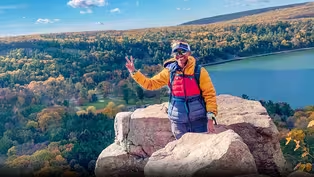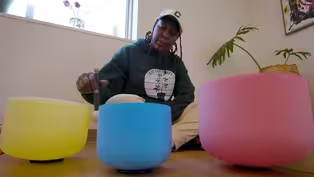
Botanical Dyer
Clip: Season 10 Episode 7 | 4m 22sVideo has Closed Captions
A botanical dyer shares her process creating a wide range of colors while teaching others.
Kipp Inglis found botanic dyeing after dyeing with chemicals for years. Ever since, she has been fascinated by the wide options of colors of natural dyes. Layering these different dyes helps her to create a wide range of colors and effects. Inglis shares her knowledge with others through classes that help her also learn through the experimentation of her pupils.
Problems playing video? | Closed Captioning Feedback
Problems playing video? | Closed Captioning Feedback
Wisconsin Life is a local public television program presented by PBS Wisconsin
Funding for Wisconsin Life is provided by the Wooden Nickel Fund, Mary and Lowell Peterson, A.C.V. and Mary Elston Family, Obrodovich Family Foundation, Stanley J. Cottrill Fund, Alliant Energy, UW...

Botanical Dyer
Clip: Season 10 Episode 7 | 4m 22sVideo has Closed Captions
Kipp Inglis found botanic dyeing after dyeing with chemicals for years. Ever since, she has been fascinated by the wide options of colors of natural dyes. Layering these different dyes helps her to create a wide range of colors and effects. Inglis shares her knowledge with others through classes that help her also learn through the experimentation of her pupils.
Problems playing video? | Closed Captioning Feedback
How to Watch Wisconsin Life
Wisconsin Life is available to stream on pbs.org and the free PBS App, available on iPhone, Apple TV, Android TV, Android smartphones, Amazon Fire TV, Amazon Fire Tablet, Roku, Samsung Smart TV, and Vizio.
Providing Support for PBS.org
Learn Moreabout PBS online sponsorship[warm, carefree acoustic guitar] In Lodi, on a busy corner in an old car dealership building... - Kipp Inglis: I do like being down here in Lodi.
I like the interaction.
- ...is an artist who makes her craft from natural dyes.
- Kipp Inglis: I'm just a color freak.
I like color.
Most chemical dyes are made with metal salts, and some of those are pretty caustic.
The natural dyeing that I do, and I prefer to call it 'botanical dyeing,' is pretty much with everyday chemicals that we use in the kitchen.
- For Kipp Inglis, it took a while to learn the joys of natural pigments.
- I was a acid dyer for years, using dyes that use vinegar, basically.
And about eight years ago, was introduced to dyes made from plants that we could get this range of colors from something that's so readily available.
Just fascinated by the process.
So, decided to relearn dying from that point of view.
I'm always looking for a wider range of colors that I can get from the plants, and the challenge of doing it-- we have to do this all on natural fibers.
It's easy to do on wool, little harder on silk.
I've just started using hemp, and I love it.
Very difficult on cotton, and I love trying to do it on cotton.
I'm just the facilitator.
Mother Nature is in charge of all of this.
I just kind of bring it to the light.
- Kipp highlights Mother Nature's ability to provide a variety of rich dyes.
- I use madder from madder root.
I use cochineal from cochineal bugs.
I use weld, which is a fast-growing weed that's easy to grow for a fantastic yellow.
And then, I use indigo.
And indigo has a whole different process than all the other dyes.
Right now, indigo is kind of at the top of the list for everybody.
It's very popular, and I love using it.
And combining those dyes will give you a very, very wide range of colors.
Reusing and sustainability are driving factors in the process.
I guess I'd like us to understand that we should stop buying new wardrobes every two years and start reusing what we've got.
My Boro process over here, the stitching is old, old, old technique from Japan, where they would keep garments going for generations.
It was much easier just to patch and keep going.
- Learning and passing on that knowledge pushes Kipp to continue experimenting and teaching.
- Because I'm a process person, that's mostly what I teach is process.
There is some, I guess, if you want to call it recipe work that I teach them.
But to see the excitement on their faces when they can make something work, and then, beyond that, to see what they do with it afterwards.
I don't consider myself a very good artist, but a lot of my students have become very, very good artists, and that, to me, is-- just keeps me going.
♪ ♪
Video has Closed Captions
Clip: S10 Ep7 | 3m 56s | Despite no formal art training, 80-plus-year-old metal artist is garnering attention. (3m 56s)
Video has Closed Captions
Clip: S10 Ep7 | 4m 37s | Dini Dowd loves nature and uses her platform to encourage everyone to get outdoors. (4m 37s)
Video has Closed Captions
Clip: S10 Ep7 | 6m 56s | Camille Mays is trying to make a difference in Milwaukee by fighting bullets with blooms. (6m 56s)
Providing Support for PBS.org
Learn Moreabout PBS online sponsorshipSupport for PBS provided by:
Wisconsin Life is a local public television program presented by PBS Wisconsin
Funding for Wisconsin Life is provided by the Wooden Nickel Fund, Mary and Lowell Peterson, A.C.V. and Mary Elston Family, Obrodovich Family Foundation, Stanley J. Cottrill Fund, Alliant Energy, UW...














